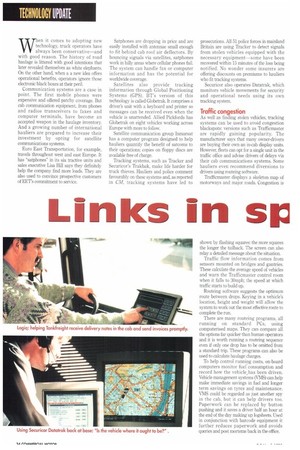W en it comes to adopting new technology, truck operators have
Page 36

Page 37

If you've noticed an error in this article please click here to report it so we can fix it.
always been conservative—and with good reason. The history of road haulage is littered with good intentions that later revealed themselves as white elephants. On the other hand, when a a new idea offers operational benefits. operators ignore those electronic black boxes at their peril.
Communication systems are a case in point. The first mobile phones were expensive and offered patchy coverage. But cab communication equipment, from phones and radios transceivers to faxes and computer terminals, have become an accepted weapon in the haulage inventory. And a growing number of international hauliers are prepared to increase their investment by opting for satellite communications systems.
Euro East Transportation, for example, travels throughout west and east Europe. It has "satphones" in its six tractive units and sales executive Lisa Hill says they definitely help the company find more loads. They are also used to convince prospective customers of EET's commitment to service. Satphones are dropping in price and are easily installed with antennae small enough to fit behind cab roof air deflectors. By bouncing signals via satellites, satphones work in hilly areas where cellular phones fail. The system can handle fax or computer information and has the potential for worldwide coverage.
Satellites also provide tracking information through Global Positioning Systems (GPS). ET's version of this technology is called Globetrak. It comprises a driver's unit with a keyboard and printer so messages can be received even when the vehicle is unattended. Allied Pickfords has Globetrak on eight vehicles working across Europe with more to follow.
Satellite communication group Inmarsat has a computer program designed to help hauliers quantify the benefit of satcoms to their operations; copies on floppy discs are available free of charge.
Tracking systems, such as Tracker and Securicor's Trakbak, make life harder for truck thieves. Hauliers and police comment favourably on these systems and, as reported in CM, tracking systems have led to
prosecutions. All 51 police forces in mainland Britain are using Tracker to detect signals from stolen vehicles equipped with the necessary equipment—some have been recovered within 15 minutes of the loss being notified. No wonder some insurers are offering discounts on premiums to hauliers who fit tracking systems.
Securicor also operates Datatrak, which monitors vehicle movements for security and operational needs using its own tracking system.
Traffic congestion
As well as finding stolen vehicles, tracking systems can be used to avoid congestion blackspots: versions such as Trafficmaster are rapidly gaining popularity. The manufacturer says that many owner-drivers are buying their own an in-cab display units. However, fleets can opt for a single unit in the traffic office and advise drivers of delays via their cab communications systems. Some hauliers even recommend diversions to drivers using routeing software.
Trafficmaster displays a skeleton map of motorways and major roads. Congestion is Lucas Kienzle equipment and software is being evaluated by Thorntons the confectioners, Logistics executive John Pollard says the company is pleased by the results. The trial is part of Lucas Kienzle's Wisedrive project involving a number of companies with financial support from the European Commission. Initial findings are that UK hauliers could improve profitability by 3%; fuel consumption could be reduced by up to 12%—some agency drivers achieved 30%—and journey times could be cut by 11% although top speeds were down.
Another user of Lucas Kienzle equipment is Ken Atkins of Atkins Transport. He says the company is concentrating on using the technology to keep engine speeds below 1,700rpm in a bid to reduce fuel and maintenance costs. But he warns that technology needs comrnimient from the top if it is to help cut running costs. He points out that it is the drivers who are delivering the benefits, not the technology itself. With the Government committed to to increasing fuel tax faster than inflation, monitoring furl consumption will become more and more important, says Atkins,




























































































